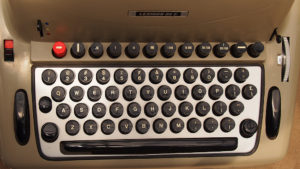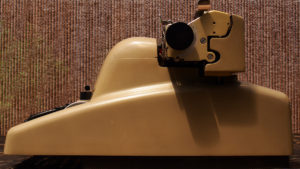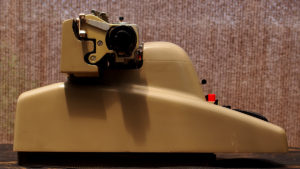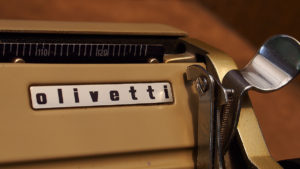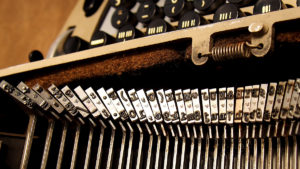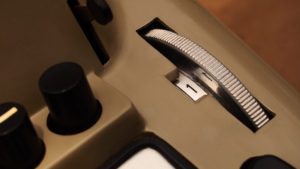
Model: 1958 Olivetti Lexikon 80 Elettrica [1069991]
Production Run: 11 years (1950-1961)
The Competition: Olympia SGE; IBM Model C
Significance: Olivetti’s first electric typewriter
“Are you sure?” the text message asked. It was easy to identify the second-guessing that was going on between the lines of the message sent to me by a fellow typewriter collector. A man of immeasurable luck when it comes to finding typewriters in such places, he had stumbled upon an Olivetti Lexikon 80E in a thrift store, and thought that I might want it; however, it was only now that he began to fully grasp the Olivetti’s imposing mass, and the distance he would have to carry it to his car was weighing heavily on his mind.
“It won’t power up,” read a subsequent text. It was obvious that he was attempting to talk me out of the deal, but it was too late: Whether or not the Olivetti worked was of little consequence to me, the significance of the model was simply too great – I had to have it.
Post-war Olivetti typewriters, much like fashion supermodels, only hold a superficial appeal for me, and as a result I don’t buy Olivetti typewriters for the way they type, but solely for how they look. The keyboards of the ultra-portable models are awkward to use for my large-size hands, and I’ve found that the full-size portables typically have wooden, erring on heavy type actions. Most disappointing for me are the standards: From a purely performance perspective, the Lexikon through to Linea 88 model range is a group of underachievers when compared to other machines from the same era.

This disparity between visual and mechanical execution can be blamed on Olivetti’s fixation on transforming typewriters into objects of style. It’s no secret that Olivetti as a corporation was obsessed with the aesthetics of everything under its control. Regardless if it was the design of its office buildings or the look of its promotional materials, Olivetti, more than any other typewriter manufacturer, wanted to ensure that a visual statement was being made. Proof of this was Marcello Nizzoli, the company’s chief design consultant responsible for the Lexikon models. The graphic designer started with the company in an architectural and publicity role before designing actual typewriters, some sources even claiming that he was more concerned with the appearance of a typewriter than how it actually worked.
The result of this passion is undeniable, and Olivetti designs are so evocative that you can’t blame a typist for expecting a superlative experience when using one, or to feel let down when the experience turns out to be average at best. Against the seemingly endless backdrop of staid and stereotypical typewriter designs, Olivetti models more than any other stand out from the crowd. As a collector I’ve come to appreciate Olivetti models for their strengths, which are bold, sometimes daring designs that you want to own just for their looks and to hell with how they actually type.
This is where the Lexikon 80E steps into the conversation. Its wonderfully bulbous lines are reminiscent of a Rubenesque woman, and yet its design somehow manages to belie its true girth and one has to applaud the machinations responsible for concealing its heinous mechanical complexity in such a pleasing form.

Particularly when juxtaposed with a Lettera 22, or even a standard Lexikon 80 for that matter, it’s easy to appreciate the artistic effort that went into creating Olivetti s first electric typewriter. Arguably, the only real downside to this electromechanical sculpture is its weight, and because of it my friend had good cause to try and renege on his offer. I imagined that when he was finally forced to carry it out to his car it must have felt like he was carrying a limp body out of a fire. When it was my turn to handle the Italian leviathan, my typewriter scale was its first stop. My eyebrows raised when I watched the scale’s spinning dial stop at 59.2 pounds (26.9 kg) and I realized that the Olivetti was a full four pounds heavier than the reigning heavyweight in my collection, the Olympia SGE 50/51. Those fortunate enough to find an 80E fitted with the optional carbon ribbon system would have a 60-plus pound machine to contend with, and a good reason to cancel their gym membership.
After a cursory cleaning and having satiated my initial desire to just enjoy the view, I moved on to more practical matters and plugged the machine in. My friend had not lied, it didn’t work. The problem was quickly diagnosed, and with its defective power cord repaired the Lexikon fired to life. To my relief everything functioned as it should, and although the machine types willingly there is an odd clunking sound coming from underneath the hood that will require further investigation.
While testing the machine it became obvious that its electromechanical mechanism was a great equalizer, and that this Olivetti standard was endowed with the best of both worlds: it had both beauty and performance. The inherent characteristics of the electric typewriter addresses my biggest complaint with mechanical Olivetti standards having disappointing type actions, and to steal and adapt a little Hunter S. Thompson, the Lexikon 80E’s typebars leap up with the slightest touch of its keys like frogs in a dynamite pond. For someone who would have considered a non-functional electric Lexikon money well spent, this was purely a bonus.
Atlas may shrug at all this mortal prattle, but I consider the Elettrica Lexikon a must-have for any collector whose appreciation of typewriters transcends the practical and enters the realm of art.
the Details: Olivetti Lexikon 80E



















